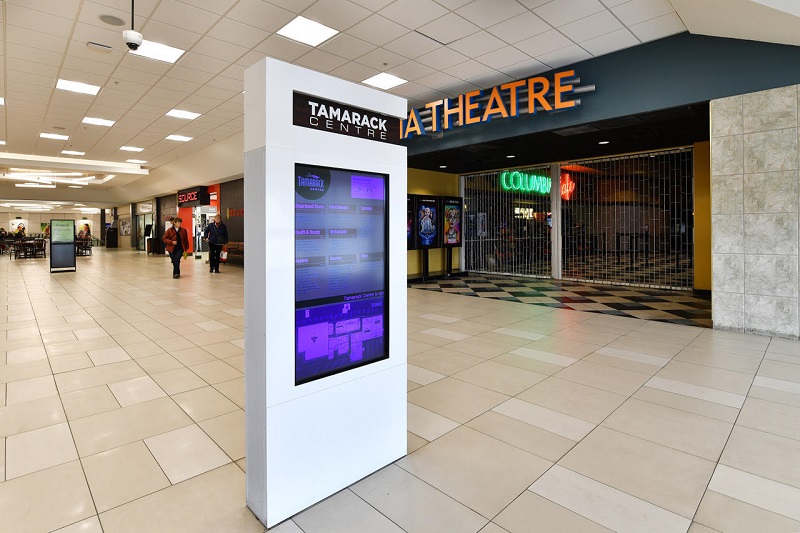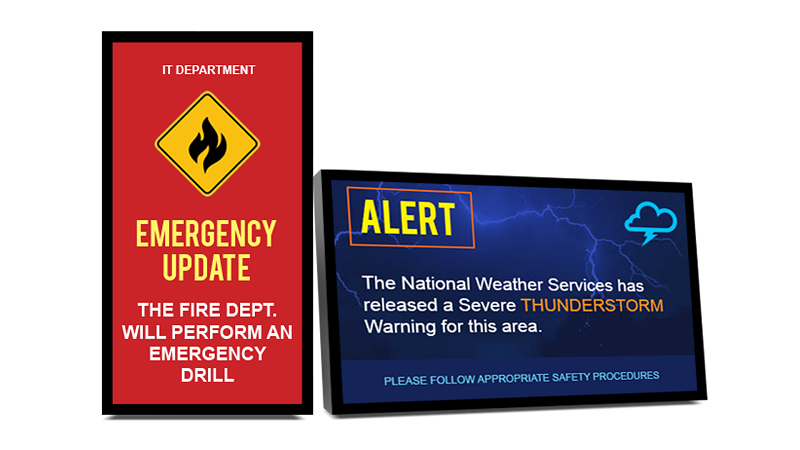A Comprehensive Guide to Digital Signage | Infographic
Digital signage is one of the most powerful tools available to organizations today. Whether you hope to attract more customers, better engage with current traffic, communicate within your company, or promote information, digital signage offers a solution. Many business leaders understand that they could benefit from digital signage but they aren’t sure where to start. Here, we’ll break down everything you need to know with a complete digital signage guide.
What is Digital Signage?
Digital signage refers to the use of technologies such as projection, LED, or LCD screens to display content that might include video, streaming media, graphics, and general information.

Every industry and companies of every size can benefit from a smart digital signage strategy. From restaurants to factories to office buildings and churches, digital signage is all around us and is a sector that continues to grow. In fact, the global digital signage market is expected to hit $29.8 billion by 2024. That might be because 80% of brands that use digital signage record a substantial increase in sales. You might hear a lot of terms that fall under the overarching umbrella of digital signage. From the technology platform to the individual displays, there are several components of digital signage.
Why Choose Digital Signage?
There are several advantages to using digital signage, and most of them boil down to these larger benefits:
- The ability to sell more products or services by attracting and engaging customers
- The ability to increase employee productivity and satisfaction through better communication and engagement
When properly implemented, a digital signage platform can help organizations achieve both of those goals. Modern digital signage is one of the most effective ways to communicate with people inside or outside of your company. For a comprehensive guide to the benefits of digital signage, check out our article on all the ways digital signage can help your business to thrive. Generally speaking, you can expect the following from digital signage:
- The ability to provide information in real time
- Flexibility and versatility
- Opportunities for customized content
- Increased efficiency and cost reduction
- Resource savings
- Enhanced employee engagement
- Creation of brand loyalty
- Marketing and sales effort support
- Increased employee morale
- Reduction in perceived wait time for customers
- Environmentally-friendly way to share information
Types of Digital Signage
There are essentially hundreds of kinds of digital signage. If you’ve ever been in a shopping mall, airport, or gas station chances are you’ve seen a variety of digital signage in different sizes and configurations. One of the great things about digital signage is how versatile it is and that it can be implemented in many different ways that are unique to a business. Some of the most common types of digital signage are digital posters, free-standing digital advertising displays, ceiling-mounted digital signage, and outdoor digital signage.
Digital Posters
A simple and easy-to-use option, this form of signage appears as a poster on an LCD or digital screen laid flat against a wall. The screen can be mounted portrait (vertical) or landscape (horizontal). They are simple to create and install which makes them a great option for brands just starting out with digital signage.
Free-Standing Digital Advertising Display
A more substantial option, these displays are ideal for making a statement. They are great for interactive use such as kiosks that feature touch-screen compatibility.

Ceiling-Mounted Digital Signage
These signs display information in a less obtrusive way. Though it might be less obvious, this sort of signage can display all types of information while being configured to work with more spaces.
Outdoor Digital Signage
An increasingly popular option, these can replace traditional billboards for advertising and also work in versatile ways outside of individual businesses. It’s worth noting that displays need to be waterproof and contain adequate heating, cooling, and airflow systems.

How to Use Digital Signage
Intrigued? Digital signage can offer plenty of revenue-boosting benefits to your company, but it’s important to adopt a thoughtful and intentional strategy before getting started. Organizations who don’t take the time to properly implement a digital signage strategy may miss out on some of the ROI they were hoping to experience. Be sure to follow these steps to ensure you’re laying the proper foundation for a successful signage strategy.
1. Identify Organizational Challenges
First, you need to understand the goals or challenges you’re attempting to address with digital signage. Naturally these will vary by industry and by business, but ask yourself (and your stakeholders) what hurdles you need to overcome and what objectives digital signage can help you achieve.
Are you hoping to:
- Increase sales?
- Improve engagement?
- Enhance productivity?
- Reduce wait times?
- Increase event attendance?
- Drive more traffic?
- Advertise more products?
- Better guide people within your building?
There are so many things that digital signage can help with, but taking a one-size-fits-all approach will not enable you to reach your goals. For example, placing advertising signage outside your retail storefront will likely help drive traffic into your space – but it won’t provide any information to people who have already made it inside. Similarly, focusing on an employee strategy requires quite a different set of tools than a customer-focused one. Take the time to document and then review the specific challenges you’re trying to address.
2. Identify a Digital Signage Champion
Any corporate initiative needs a white knight – a person who will take on the responsibility of managing said initiative, as well as advocating for the necessary budget and resources. Digital signage is no different. In order for your implementation to be successful, leadership needs to identify the person who will be “in charge”. This person will:
- Make sure the digital signage content is relevant and fresh
- Measure the impact of digital signage
- Manage the users of digital signage
- Stay up to date with emerging trends
- Make sure the digital signage system is current
- Answer questions from others in the organization about digital signage
- Report on all things digital signage-related to management
3. Identify Project and Team Stakeholders
You’ve identified a champion, but that person can’t work in a silo. While they will ultimately be responsible for several key tasks associated with digital signage, they can’t do it alone.

Who is going to make decisions around all things digital signage? This will vary across organizations. Managers should talk to end-users to ensure they truly understand the needs of the organization. Final decisions could rest with one individual or with a team of individuals who contribute to discussions.
4. Conduct a Site or Location Survey
Where will you place digital signage? This is one of the most important components of an implementation plan. Location matters almost as much as content – after all, if no one can see your signage, the information on it won’t matter much.
The locations of signage should maximize ROI. Think about the challenges and goals you documented and then consider which locations align with those tactics. You also need to consider the size of any screens – where can they fit naturally? What will need to be reconfigured? Internet connection? Connectivity is also key: you need access to power as well as the internet. Poor connections or a slow signal can deter the signage working.
5. Set Goals for the Implementation
These goals will be more specific than addressing the challenges we talked about earlier. Here, you will determine what exactly you want to do with digital signage, and the metrics to go along with those goals.
For example, if one challenge is getting more traffic into your store and you have determined that outdoor digital signage can help with that, then a goal could be to “Increase foot traffic by 20% within the first month of signage implementation”.
It’s important to get the metrics right, so that you can understand if your strategy is really working. Part of that goal-setting is also establishing a timeline. You may want to review SMART goal setting (and here is a great blog on the topic to help you out).
6. Define Content Requirements
Content is king. Again, this will vary based on not only your industry and your business but on the goals you are trying to reach and the challenges you’re trying to address. One thing is certain across the board though: compelling content is critical if you want your digital signage to be successful. Considering your digital signage design is important.

What does your organization need to display? A school will display different information than a restaurant. What information does your audience want or need? Focus on these areas and understand the requirements before putting together a content guide or calendar as well as guidelines for your content.
7. Define Network Requirements
You may need to loop in a co-worker in the IT department to help with this element. What does your digital signage require from your network? How big are your media files? Are you planning for a wired or wireless setup? Can all of the wires properly reach the display? How many displays or devices are you wanting to connect? If you’ll be going wireless, is there a good connection to the router?
8. Define Budgets
Remember the digital signage champion we talked about earlier in this guide? They’ll need to put together a budget for digital signage including implementation and maintenance. A complete budget will include hardware elements, software, installation costs, and content creation expenses.
It’s smart to have several recommendations at each stage. For example, creating content in-house will present a totally different cost structure than leveraging an experienced expert. Do you have the technical skills to install the components in house, or will you rely on a partner for that? How about training the staff who will use it? Think of the digital signage process from start to finish and put together a couple options for budget within each area.
9. Choose your Software
Digital signage software is the central platform for creating, deploying and managing dynamic content on your digital signs. It’s essential to choose the right software that will meet your company’s unique needs. The content management system (CMS) you chose will effect every area of your digital signage display. It can affect the available layouts for your display, playback, which apps you have access to like social media apps and more.
You may find software is included in the signage option you select. You can also add software from a third-party. Many people find cloud-based software easiest to use. You want to look for a software that is flexible enough to meet your needs but can also scale as your program grows. Cost is often a factor as well, and sometimes software is free if you invest in a digital signage solution. At Mvix, our software is hardware agnostic, easy to use, and supports over 150 content sources and data integrations.
10. Decide on a Media Player
Media players are another critical component. Do your needs require displaying on 1 screen or 100? That will be important in choosing a solution. Options range from built-in media players to “sticks” or stand alone players. Sticks tend to be less expensive but also have less capabilities. Stand-alone players are larger and more expensive but also more powerful.
11. Choose your Screens
At a basic level, the choice is between commercial and consumer grade screens. Commercial grade screens are highly recommended for businesses as they are built for durability and long term usage. For instance, a digital signage screen may need to stay on 24/7 where a consumer screen wouldn’t need to stay on this long. Commercial grade screens do require more investment up front but you can expect a better result over a longer period of time.

The size of the location where they’ll be used also matters, as bigger screens will need to be used when being viewed from farther away. Also, it’s worth noting that consumer screens are really built to be used for viewing TV, movies, and video games, whereas commercial displays can better adapt to all types of content and work better in brighter environments.
12.Implementation and Rollout
It’s important to make sure you have a thoughtful plan in place for actually installing and implementing your digital signage. Who is responsible for rolling-out the new program and maintaining it once it’s installed? In many instances this person will be the champion we already talked about, but not always.
A smart project plan will cover the following elements:
- Procuring components
- Training the team
- Creating a content guide and schedule
- Rolling out a pilot program
- Reviewing and refining the project plan
- Rolling out the remainder of the project
13. Measure ROI and Adapt
ROI, or Return on Investment, represents the efficiency of an investment. The goals you determined earlier in the process should have specific metrics tied to them. Set up a regular review cycle for measuring this data and reporting on it.
From there, you need to understand what’s working and what isn’t, and adjust your strategy. Perform different tests, and tweak tactics as you go based on the results you’re seeing. Continuous improvement is the name of the game.
Frequent Challenges in Digital Signage
Before you go all-in on a digital signage solution, it’s important to understand some of the challenges you may end up facing. The most substantial hurdle we hear about from clients is keeping content fresh and engaging. One of the most important advantages of digital signage is that it’s not static – it’s incredibly flexible and customizable. But companies that don’t take advantage of these features often find that signage isn’t performing how they’d hoped. To maintain digital signage’s effectiveness, it’s important to change content frequently. Many users report only changing content once per month, and that’s simply not enough for most industries.

We suggest creating a content guide and schedule in advance. How often you need to change content depends completely on your sector and your audience, but you need a plan in place no matter what. Consider who you’re talking to, what you’re sharing, sales and promotional offers, seasonality, etc. All of these factors can contribute to a documented schedule. It’s always a good idea to keep a stockpile of photos and media handy to use when you need a refresher or put them into a playlist. Remember, content doesn’t have to be new, it just has to feel new to the people who view it.
Content Creation
Many companies struggle with creating a content calendar and keeping visuals fresh, even when they know how important it is to do so. In these cases, it can make sense to invest in a content design service such as our Content Refresh Service, which offers unlimited custom designs each month, guaranteed to keep your signage fresh and interesting.
Digital Signage Guide Takeaways
Digital signage works. Savvy business owners are implementing it at a rapid pace, with 60% of enterprises without digital signage in their stores planning to invest in the technology within the next two years.
That being said, digital signage is certainly not a set-it-and-forget-it program. Managers must create a structured, thoughtful plan to select and implement the hardware, software, installation, and content creation plan that’s right for their organization. Carefully following the steps laid out in this digital signage guide will help you to develop a program that is sure to generate ROI for years to come. If you’re not sure where to start, or you’re strapped for bandwidth or resources, partnering with a robust digital signage solution can make your life a lot easier. So, just reach out to one of our experienced solutions consultants.
Digital Signage Guide Infographic
We also created an infographic below you can use as a guide with the 13 steps of digital signage:




